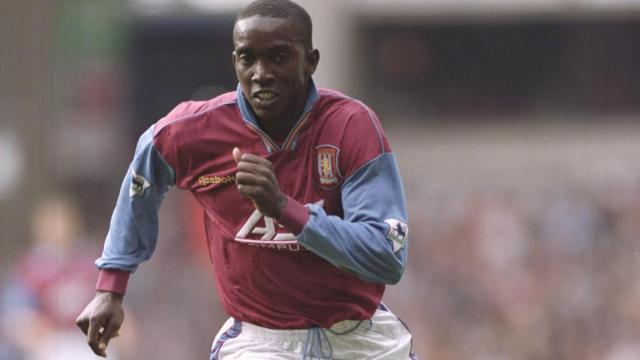Dwight Yorke’s football career is undoubtedly most famous for his part in Manchester United’s Treble Win. But outside of that, the striker is most known for a relationship with Jordan (no, not the country, but the one with the boobs) and for saying how great he’d be as Aston Villa Manager.
And, why Aston Villa? Because he used to play for them! Not that that’s any real revelation to anyone who watched 90s Premier League football. But still, here’s how Dwight Yorke ended up at Manchester United.
Yorke had a start in football that would almost certainly never be seen in the Premier League these days. Having just finished 17th in their first season back in the First Division, Aston Villa set off on a West Indian Tour. It was in one of their friendlies there that manager Graham Taylor decided to hand a trial to who was effectively a random player who had once looked decent against them. That player was Dwight Yorke, and his trial evidently went well enough that he was offered permanent terms with Aston Villa – and, just like that, Yorke was a Premier League footballer.
Villa shot up the table in 1989/90, eventually finishing as runners-up to Liverpool. Yorke didn’t feature until right at the end, however, making his debut in March and playing just twice.
His second season saw him feature more, however, with 18 Premier League games and two goals in a season; where Villa sunk right back down to seventeenth. That change in fortune for the side had come about after a change of manager – Graham Taylor, the man who had first taken the chance on Yorke, had left to take over as England manager.
Jozef Vengloš had taken over after guiding Czechoslovakia to the World Cup quarter-finals (becoming the first non-British or Irish manager to take charge of a First Division team), but Villa’s slide down the table saw him sacked at the end of the season and replaced with ‘Big’ Ron Atkinson.
The important thing to note though is that Yorke initially started as a right winger. It would be a few years before he was leading the side in a centre forward role, but 91/92 was something of a breakout season.
Yorke hit 11 goals in the final season of the ‘Old’ First Division – before the Premier League began the following season. It was a good season for Villa, too, as they pushed right up to 7th in Atkinson’s first season.
A front two made up of club-record signing, Dean Saunders, and Dalian Atkinson were pushing Villa forward, and Yorke’s contribution to the 92/93 season was more withdrawn – he scored just the six – while the next season he managed just the two league goals in 12 games.
Villa won the Coca-Cola Cup that year, although Yorke wasn’t in the squad.
Yorke would have one more year on the fringes (six goals in 94/95) but that summer both Saunders and Atkinson were sold to Istanbul. It was a strange move, with Saunders joining up with Grahame Souness at Galatasaray, while Atkinson went to Fenerbache. Yorke, under new manager Brian Little, suddenly became the main man.
Goals followed. 34 Premier League goals in the next two seasons, 45 in all competitions. In 1996, Villa reached the League Cup final again, this time against Leeds United. Villa won 3-1, with Yorke scoring the third.
Now Yorke was a Premier League superstar, sharing the top scorers’ charts with the likes of Shearer, Fowler, Ferdinand, Cantona, and Wright. Villa were consistently finishing in the European places under Little, but things changed at the end of the ’97 season.
Villa smashed their club record to sign the wasted-talent Stan Collymore from Liverpool in May that year, meaning Yorke was no longer the leading striker at the club. Yorke still finished as top scorer, what with Collymore’s talent being wasted, but with just the twelve goals.
Villa also had a strange season, as being 15th in February saw Little sacked and replaced with the relatively inexperienced John Gregory. Gregory managed to turn things around, however, with Villa finishing a respectable 7th. They even qualified for Europe again.
Yorke had built a hell of a reputation by this stage, and interest from other clubs had been known for a while – particularly Manchester United. On the face of it, United look downright greedy to be considering striking options of Andy Cole, Teddy Sheringham, and Ole Gunnar Solskjaer and deciding that they could use another centre forward – although hindsight does a pretty solid job of proving them right.
The transfer was hardly smooth, however. Villa, understandably, wanted the deal to suit them too, asking for Andy Cole in return. United were far from interested in that one though, and instead chose to wait. Yorke proceeded to go to John Gregory and explain that he wanted to move, a meeting that Gregory did not look on favourably.
“If I had a gun, I would have shot him.”
John Gregory
Still, Villa tried to hold out. Yorke started their first game of the season against Everton but looked so pathetically uninterested that the club felt they had no choice but to sell him – a far cry from these days where everybody just pretends they’re injured or ill.
A £12.6m bid was accepted and Yorke moved to Man United on August 20th, 1998. He had a decent first season there – 29 goals and The Treble – so in the end, it was a pretty great move for him.
His reputation with Villa probably isn’t what it should be, though. The way he quit the club left a sour taste in the mouth, and despite being a one-time Villa hero, he joined Birmingham City in 2004. Here – for reasons only he might be able to understand – he claimed that Birmingham were a bigger club than Villa. Smooth.
Yorke’s career was an interesting one, and it’s certainly quite sad that “The Smiling Assassin” fell apart so rapidly after his United move, let alone that he tore up his own reputation with Villa. One thing that certainly hasn’t changed is that Dwight Yorke remains one of Aston Villa’s most gifted ever players.

